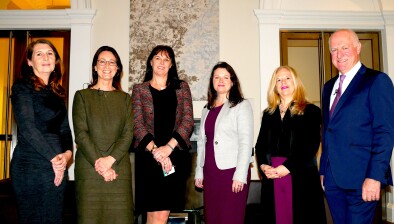Number of women on FTSE boards up by 50% in five years
The number of women on FTSE boards has increased by 50% in the last five years, according to the newly released Hampton-Alexander Review.

More than a third (34.3%) of FTSE 350 board positions are now held by women, with the number of women on boards rising from 682 to 1026 in five years.
The data has been published in the final report from the government-backed HamptonAlexander Review, which was launched in 2016 to encourage UK-listed companies to appoint more women to their boards and into senior leadership.
While men still dominate in the upper ranks of the UK’s top firms, in five years the Review has seen remarkable progress among FTSE companies. In total, 220 of the FTSE 350 companies now meet the Hampton-Alexander target of having at least 33% of their board positions held by women - with the figure having quadrupled from just 53 in 2015, and there are no longer any All-Male boards in the FTSE 350.
The figures also show an increase in women in wider senior leadership roles, demonstrating that Hampton-Alexander’s top-down approach - with boardrooms setting the standards for women’s representation across the company - is providing pathways to success for women and ultimately supporting British business to strengthen leadership with new ideas and diverse perspectives that come from more women in senior positions.
The FTSE 250 reached the Hampton-Alexander Review’s final target of women making up 33% of boards in December 2020, following the FTSE 100 and FTSE 350, which achieved the milestone in February and September 2020 respectively, highlighting the success of the Government’s voluntary, business-led approach in addressing the exclusion of women from the top of FTSE companies.
Sir Philip Hampton, Hampton-Alexander Review chair, said: “There’s been excellent progress for women leaders in business over the last 10 years or more, with boards and shareholders determined to see change. The progress has been strongest with non-executive positions on boards, but the coming years should see many more women taking top executive roles. That’s what is needed to sustain the changes made.”
Denise Wilson, Hampton-Alexander Review CEO, added: “The lack of women in the boardroom is where it all started a decade ago, and it’s the area where we have seen the greatest progress. But now, we need to achieve the same - if not more - gains for women in leadership.
“The supply of capable, experienced women is full-to-over-flowing. It is now for business to fully-utilise a talent pool of educated, experienced women, to their own benefit and that of the UK economy.”
Mary O’Connor, acting senior partner at KPMG UK, said: “It’s hard to believe that as recently as 2011, 43% of the FTSE 350 still had All-Male boards. Thankfully the representation of women on boards and in leadership positions has significantly improved in recent years, with this review having played a critical role in realising that.
“Achieving the review’s 33% target at boardroom level marks great progress, but it’s vital we have a strong pipeline of female talent rising the ranks. While women now make up nearly a third of wider senior leadership roles, structural and cultural barriers still exist for women, as well as other underrepresented groups.
“Our collective efforts to truly eradicate those barriers and create an inclusive leadership culture doesn’t stop here, this is where it intensifies.”








